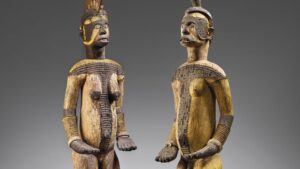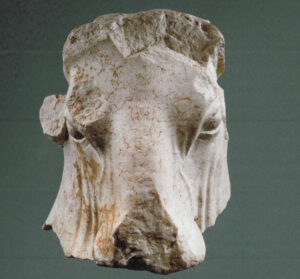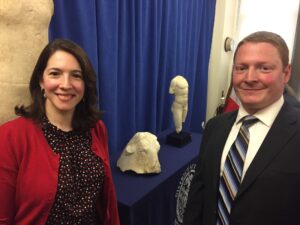by Amineddoleh & Associates LLC | Jul 6, 2020 |
Readers may recall from a previous blog post that Facebook Marketplace has become the subject of criticism for playing host to antiquities traffickers selling looted cultural heritage items online. Employing Facebook’s sophisticated algorithms, traffickers quickly connect with buyers receptive to purchasing plundered goods or with less experienced buyers who do not recognize the red flags associated with looted antiquities. Red flags include an origin from a conflict zone (such as Syria or Iraq), lack of provenance or export documents, and comparatively low prices in relation to the object’s scarcity or true value. Online sales have flourished after the looting of cultural heritage sites during and after the Arab Spring, and illicit trafficking of antiquities has been recently exacerbated by the COVID-19 pandemic, which has left many cultural heritage sites defenseless and ripe for plunder. Antiquities as varied as scrolls, coins, and even mummified human remains are sold through online groups. More troubling is the fact that members would discuss how to illegally excavate historical sites. Some members provide tips on how to avoid law enforcement officials, while others make specific “loot to order” requests, deliberately targeting specific objects. The smuggling of Middle Eastern antiquities has been linked to terrorist groups and other crime syndicates. While physical border security may be tightened, it is more difficult to tackle online transactions.
 As a result, groups like the ATHAR Project have been demanding changes. “Athar” is the Arabic word for antiquities, but the name also stands for “Antiquities Trafficking and Heritage Anthropology Research.” Co-Directors Prof. Amr Al-Azm and Katie A. Paul have dedicated the project to ascertaining relationships between the digital underworld, transnational trafficking, terrorism financing, and organized crime. The founders have spoken to media outlets to assist investigations into the issue. In response to this outcry, Facebook announced a change in policy to ban from its marketplace any “content that attempts to buy, sell, trade, donate, gift or solicit historical artifacts.” The change was made effective as of June 23, 2020.
As a result, groups like the ATHAR Project have been demanding changes. “Athar” is the Arabic word for antiquities, but the name also stands for “Antiquities Trafficking and Heritage Anthropology Research.” Co-Directors Prof. Amr Al-Azm and Katie A. Paul have dedicated the project to ascertaining relationships between the digital underworld, transnational trafficking, terrorism financing, and organized crime. The founders have spoken to media outlets to assist investigations into the issue. In response to this outcry, Facebook announced a change in policy to ban from its marketplace any “content that attempts to buy, sell, trade, donate, gift or solicit historical artifacts.” The change was made effective as of June 23, 2020.
Although the ban is an encouraging step towards the eradication of antiquities trafficking, Facebook’s decision is indicative of a larger problem facing the art market: the move to online sales spurred by developments in technology, and more recently the pandemic, has rendered the market more vulnerable to traffickers selling loot. Closing the Facebook Marketplace to “historical artifacts” is perhaps a well-intentioned gesture, but it fails to adequately address the concerns in the larger market. An expert was quoted as suggesting that Facebook should invest in specialized teams to identify and remove criminal networks at their source rather than “playing whack-a-mole with individual posts.”
 As Facebook’s abdication from the marketplace evidences, commercial actors are rarely incentivized to police their salesrooms. Further, the responsibility for reclaiming stolen property falls on the work’s country of origin. Even auction houses, which often carry out due diligence procedures, have been known to allow works with questionable provenance to reach the auction floor (more on this trend below). Relying on nations to recover looted works is problematic. Nations protect their heritage, often through a cultural ministry or national museum. Unfortunately, governments do not have the resources to investigate the global art market or recover property through litigation. Increasing the number of smaller, online sales makes this already Sisyphean task all the more impossible. Some nations monitor the market and confront sellers when questionable works appear on the market. Greece notably faced claims in federal court in New York after it communicated with an auction house about a suspicious item. Fortunately, our client was victorious in defending itself against jurisdiction in the U.S.
As Facebook’s abdication from the marketplace evidences, commercial actors are rarely incentivized to police their salesrooms. Further, the responsibility for reclaiming stolen property falls on the work’s country of origin. Even auction houses, which often carry out due diligence procedures, have been known to allow works with questionable provenance to reach the auction floor (more on this trend below). Relying on nations to recover looted works is problematic. Nations protect their heritage, often through a cultural ministry or national museum. Unfortunately, governments do not have the resources to investigate the global art market or recover property through litigation. Increasing the number of smaller, online sales makes this already Sisyphean task all the more impossible. Some nations monitor the market and confront sellers when questionable works appear on the market. Greece notably faced claims in federal court in New York after it communicated with an auction house about a suspicious item. Fortunately, our client was victorious in defending itself against jurisdiction in the U.S.
On its face, banning cultural heritage items from Facebook Marketplace appears to be a responsible choice. In truth, Facebook is relegating a problem that it helped foster to nations that are already struggling to police the market. Critics of the ban argue that Facebook’s role in the illicit market makes the works more visible and easier for countries to locate. By closing its doors, Facebook has likely pushed these sales deeper into the black market, making them more difficult to track and recover. Further, Facebook indicated that it will not preserve information associated with the sale of artifacts, citing privacy concerns. This means that any information on the site will be destroyed rather than shared with countries of origin. Noting that “theft, pillage or misappropriation of” cultural property violates international law and constitutes a war crime, critics assert that social media evidence has been used by the International Criminal Court to prosecute and convict war criminals as recently as 2017. Facebook is ready to wash its hands of the market for looted antiquities, but in doing so, is neglecting the possibility of using its already established position to counteract the presence of looting on a more effective and direct basis.

The wooden sculptures, one male and one female, represent deities from the Igbo community. Copyright: Christie’s
Facebook is not alone in playing a troubling role in the illicit market. Whereas some traffickers exploit the dark recesses of the internet, others turn to the its most prominent levels in an attempt to legitimize a looted artwork. Due diligence measures have slipped during the COVID-19 pandemic, as buyers and intermediaries have been unable to inspect works personally. Recently, Christie’s was called upon by a prominent art historian to pull two Nigerian statues from a sale in Paris, believing the works were looted during civil war in the 1960s. At the very least, more information would be necessary to determine if the works had been exported illegally. Yet despite these concerns, Christie’s proceeded with the auction. Defending the sale, Christie’s maintained that there wasn’t “any suggestion that these statues were subject to improper export,” prior to the academic’s request. Unfortunately, this response side-steps an inconvenient truth that doubts about provenance may only surface once a work enters the global spotlight, as in an auction house sale. For instance, the lack of prior ownership claims may be due to the item being held in a private collection prior to sale. An official for the Nigerian National Commission for Museums and Monuments said he “was saddened” by the sale, but the country has not yet made a formal demand for repatriation. Despite the controversy, and perhaps encouraged by the lack of action by Nigeria, the piece sold for just under $240,000 (£195,000). Only time will tell whether the statues become the subject of litigation.
It is important for collectors to understand the particularities of acquiring antiquities, and it is important consult knowledgeable professionals to avoid problems. Amineddoleh & Associates has a wealth of experience addressing the challenges faced by foreign nations and private owners. Our founder has served as an expert for a number of high-profile repatriations. (She served as a cultural heritage law consultant in the return of thousands of looted artifacts to Iraq in the “Hobby Lobby” forfeiture, and as a cultural heritage law expert in matters such as the return of an Achaemenid relief to Iran, a golden coffin and mummy parts to Egypt, and a mosaic from one of Caligula’s ships to Italy.) This firm has represented museums, foreign nations, collectors, and sellers in litigations and transactional matters. Moreover, we routinely aid our clients in conducting due diligence to ensure that their purchases are legally permitted and free from encumbrance. As the pandemic continues and online cases soar, savvy purchasers must be as cautious as possible and contact legal counsel familiar with the art market’s pitfalls.
by Amineddoleh & Associates LLC | May 1, 2020 |
Our founder had the opportunity to speak with Sarah Cascone of Artnet about the sale of looted antiquities on social media sites. As the coronavirus pandemic continues, historical and archaeological sites are more vulnerable than ever to theft and damage. This type of vulnerability was previously witnessed during the Arab Spring and the rise of ISIS. Now, a new wave of antiquities looting has spread across the Middle East, Africa – and Facebook. As individuals in heritage-rich countries face diminished income and economic opportunities, they turn to theft, and the internet has provided countless willing buyers for looted antiquities. Facebook is a popular means for looters to display their wares and carry out sales. The Antiquities Trafficking and Heritage Anthropology Research Project is tracking and monitoring stolen artifacts in the digital underworld and notes that there has been a significant increase in these cases, including the looting of a historic mosque in Morocco last week, with images shared on relevant Facebook groups. These groups even share tips on how to proceed with excavations without getting caught. As with more traditional channels, it is illegal to sell looted antiquities through internet sites. However, criminals use loopholes to create private groups where they can sell the items quickly and before police get involved. By the time law enforcement is alerted, the objects may have already disappeared deeper into the black market, as noted by Leila. When there are financial gains with relatively little risk, looters and middlemen pursue illegal sales, and they will continue to proliferate and exploit the situation unless stronger standards of protection are put in place. With limited resources, it is difficult for law enforcement agencies to monitor the global black market. Enacting firm policies prohibiting black market items, including antiquities, from being sold on the platform would help stem the tide of looting. Facebook could potentially employ a task force or a specialized compliance team to prevent the sale of illicit goods.
While some purchasers may turn a blind eye towards the provenance of these objects, some may genuinely be unaware that their purchased goods were stolen. Red flags in these types of transactions include depressed prices, unusual sources, origination in a conflict zone, and no verifiable provenance. For collectors to ensure that they have purchased legitimate works, they should carry out due diligence and request accompanying evidence as to the object of the sale, such as documentation pertaining to legal export and permission to sell from the country of origin, customs forms, verifiable information, prior publications, and research the sellers. Collectors should also contact knowledgeable legal counsel who can assist with transactions and ensure that everything is above board. Amineddoleh & Associates is experienced in a variety of cultural heritage transactions and our founder Leila Amineddoleh has been used by the Manhattan District Attorney’s Office as a legal expert for cases involving Mediterranean and Middle Eastern antiquities. Our firm has a successful track record in helping collectors perform due diligence and establish provenance, giving them piece of mind and allowing them to enjoy their purchases for years to come.
by Amineddoleh & Associates LLC | Oct 3, 2017 |
Note: All of the information in this blog post is taken from a publicly filed document. No confidential or privileged information was used in preparing this post.
 On September 22, Matthew Bogdanos submitted an application in NY Supreme Court in a matter involving a stolen antiquity from Lebanon. Our founder served as a cultural heritage law expert on this case. It was an honor to once again work with Bogdanos, a talented trial attorney. His track record for excellence is impressive, and the filing in this case is a tour de force of legal writing, reading like a suspenseful crime narrative and primer on cultural heritage law. The document was full of famous art world names, citations to landmark cases and conventions, and introduction to the world of art crime and heritage looting.
On September 22, Matthew Bogdanos submitted an application in NY Supreme Court in a matter involving a stolen antiquity from Lebanon. Our founder served as a cultural heritage law expert on this case. It was an honor to once again work with Bogdanos, a talented trial attorney. His track record for excellence is impressive, and the filing in this case is a tour de force of legal writing, reading like a suspenseful crime narrative and primer on cultural heritage law. The document was full of famous art world names, citations to landmark cases and conventions, and introduction to the world of art crime and heritage looting.
The cast of characters involved in this matter have become household names in the heritage field. The Aboutaams (owners of Phoenix Ancient Art) have been involved in numerous legal battles; Robin Symes, described as a “disgraced” art dealer, has been connected to dozens of pillaged antiquities; Frederick Schultz (former New York gallery owner and former president of the National Association of Dealers in Ancient, Oriental and Primitive Art) served time for dealing in looted Egyptian antiquities; Michael Steinhardt, founder of a hedge fund and referred to as “Wall Street’s Greatest Trader,” has faced many legal controversies for his art collection (including this year’s disputed sale of the Guennol Stargazer at Christie’s); and Frieda Tchacos, a dealer with a history of antiquities violations has been profiled for her role in the illicit antiquities trade. All of these individuals have been featured in books like Chasing Aphrodite and the Medici Conspiracy. In fact, the dispute over the Bull’s Head reads like a redux of the Euphronios Krater debacle at the Metropolitan Museum of Art (“the Met”). However, as Bogdanos notes in the government’s filing, the Met acted “admirably” by removing the item from display and delving into the object’s past.
The current controversy involves an antiquity that was purportedly looted from storage in Lebanon during the nation’s civil war. It went missing for decades and then appeared at the Met after it was loaned to the museum by Michael Steinhardt. He had purchased the item from wealthy collectors, Will and Lynda Beierwaltes. Once Steinhardt was informed of the work’s problematic provenance, he demanded a refund for the purchase and transferred title to the object back to the couple.
One of the most interesting aspects of this case is Bogdanos’ discussion about “good faith.” The Beierwaltes are not novice collectors; they owned a collection of antiquities valued at nearly $100 million. As “professional” collectors, did they really use good faith in acquiring the antiquity? As Bogdanos rightly asks: where are the documents related to the object? If an antiquity of such high value (over a million dollars) crosses international borders multiple times, there should be documentation that traces its movements.
“There is no customs declaration form, no shipping document, no air waybill, no tracking form, no insurance form, no invoice, no bill of sale, no photograph, and no mention in any contemporaneous correspondence or email. No proof of any kind of the possession and repeated transportation across oceans and international borders of a two-millennia-old statue valued at more than one million dollars by either of the names listed by the Met on October 20, 2017.” As stated on page 45, “…twenty-four years (1981-2004) of movement across international borders of a million-dollar statue generated four handwritten words, a couple storage invoices, and one piece of paper from the infamous Robin Symes. A neon sign flashing ‘stolen’ would have been more subtle and less insidious.”
One of the disturbing aspects of this controversy is the allegation that the sculpture was taken during the civil war in Lebanon. If true, then the item was pilfered by opportunists taking advantage of political upheaval to steal priceless and irreplaceable treasures. Sadly, this type of theft occurs around the world and is still common today, particularly prevalent in Syria and Iraq.
Purchasing items without complete provenance is risky. As I explained in this editorial in The Guardian, looted antiquities are problematic from an investment perspective. Bogdanos warns against this risk, stating “The obvious, but all-too-often ignored, risks attendant to never asking about ownership history is that the buyer may one day have that purchase seized and confiscated as stolen property. Here, the absence of the required inquiry, not only subjects the Beierwaltes to potential prosecution for criminal possession of stolen property, but it also defeats any claim that they were good-faith purchasers of the Bull’s Head.”
As outlined in the government’s conclusion, there are a host of important facts to recognize in this case. (1) The Bull’s Head was excavated in 1967 and stolen in 1981 during a civil war, nearly 50 years after Lebanon’s patrimony laws (the laws vest ownership of all discovered antiquities in the nation). (2) The sculpture surfaced in the hands of Robin Symes in NY in early 1996. As revealed by several international investigations, Symes was a major participant in an antiquities trafficking network in the 1980s and 1990s. The network’s black-market supply chain started with tomb raiders, passed through the launderers and middle men, and terminated at the demand end with collectors, like the Beierwaltes. (3) The Symes-Beierwaltes relationship was responsible for 98% of the vast Beierwaltes Collection, valued at almost $100 million in 2006. The acquisition of the collection appears to have coincided with the peak of the Medici, Becchina, and Symes empire of loot. (4) There is a shocking lack of documentation produced by the Beierwaltes. (5) The lack of records is especially telling for collectors involved in the art trade for 62 years. (6) The Beierwaltes avoided submission of any materials pursuant to discovery requests, despite multiple subpoenas and repeated requests. There is also no evidence concerning how Robin Symes acquired the Bull’s Head or whether he legally possessed it. (7) Lebanon made commendable efforts to protect and to recover its cultural heritage.
A copy of the the government’s filing can be found on the Chasing Aphrodite website: https://chasingaphrodite.com/2017/09/24/the-sidon-bulls-head-court-record-documents-a-journey-through-the-illicit-antiquities-trade/

Our founder at the repatriation ceremony in 2017
UPDATE: The Bull’s Head (as well as two other pieces) were returned to Lebanon in December 2017.
 As a result, groups like the ATHAR Project have been demanding changes. “Athar” is the Arabic word for antiquities, but the name also stands for “Antiquities Trafficking and Heritage Anthropology Research.” Co-Directors Prof. Amr Al-Azm and Katie A. Paul have dedicated the project to ascertaining relationships between the digital underworld, transnational trafficking, terrorism financing, and organized crime. The founders have spoken to media outlets to assist investigations into the issue. In response to this outcry, Facebook announced a change in policy to ban from its marketplace any “content that attempts to buy, sell, trade, donate, gift or solicit historical artifacts.” The change was made effective as of June 23, 2020.
As a result, groups like the ATHAR Project have been demanding changes. “Athar” is the Arabic word for antiquities, but the name also stands for “Antiquities Trafficking and Heritage Anthropology Research.” Co-Directors Prof. Amr Al-Azm and Katie A. Paul have dedicated the project to ascertaining relationships between the digital underworld, transnational trafficking, terrorism financing, and organized crime. The founders have spoken to media outlets to assist investigations into the issue. In response to this outcry, Facebook announced a change in policy to ban from its marketplace any “content that attempts to buy, sell, trade, donate, gift or solicit historical artifacts.” The change was made effective as of June 23, 2020. As Facebook’s abdication from the marketplace evidences, commercial actors are rarely incentivized to police their salesrooms. Further, the responsibility for reclaiming stolen property falls on the work’s country of origin. Even auction houses, which often carry out due diligence procedures, have been known to allow works with questionable provenance to reach the auction floor (more on this trend below). Relying on nations to recover looted works is problematic. Nations protect their heritage, often through a cultural ministry or national museum. Unfortunately, governments do not have the resources to investigate the global art market or recover property through litigation. Increasing the number of smaller, online sales makes this already Sisyphean task all the more impossible. Some nations monitor the market and confront sellers when questionable works appear on the market. Greece notably faced claims in federal court in New York after it communicated with an auction house about a suspicious item. Fortunately, our client was victorious in defending itself against jurisdiction in the U.S.
As Facebook’s abdication from the marketplace evidences, commercial actors are rarely incentivized to police their salesrooms. Further, the responsibility for reclaiming stolen property falls on the work’s country of origin. Even auction houses, which often carry out due diligence procedures, have been known to allow works with questionable provenance to reach the auction floor (more on this trend below). Relying on nations to recover looted works is problematic. Nations protect their heritage, often through a cultural ministry or national museum. Unfortunately, governments do not have the resources to investigate the global art market or recover property through litigation. Increasing the number of smaller, online sales makes this already Sisyphean task all the more impossible. Some nations monitor the market and confront sellers when questionable works appear on the market. Greece notably faced claims in federal court in New York after it communicated with an auction house about a suspicious item. Fortunately, our client was victorious in defending itself against jurisdiction in the U.S.
 On September 22, Matthew Bogdanos submitted an application in NY Supreme Court in a matter involving a stolen antiquity from Lebanon. Our founder served as a cultural heritage law expert on this case. It was an honor to once again work with Bogdanos, a talented trial attorney. His track record for excellence is impressive, and the filing in this case is a tour de force of legal writing, reading like a suspenseful crime narrative and primer on cultural heritage law. The document was full of famous art world names, citations to landmark cases and conventions, and introduction to the world of art crime and heritage looting.
On September 22, Matthew Bogdanos submitted an application in NY Supreme Court in a matter involving a stolen antiquity from Lebanon. Our founder served as a cultural heritage law expert on this case. It was an honor to once again work with Bogdanos, a talented trial attorney. His track record for excellence is impressive, and the filing in this case is a tour de force of legal writing, reading like a suspenseful crime narrative and primer on cultural heritage law. The document was full of famous art world names, citations to landmark cases and conventions, and introduction to the world of art crime and heritage looting.